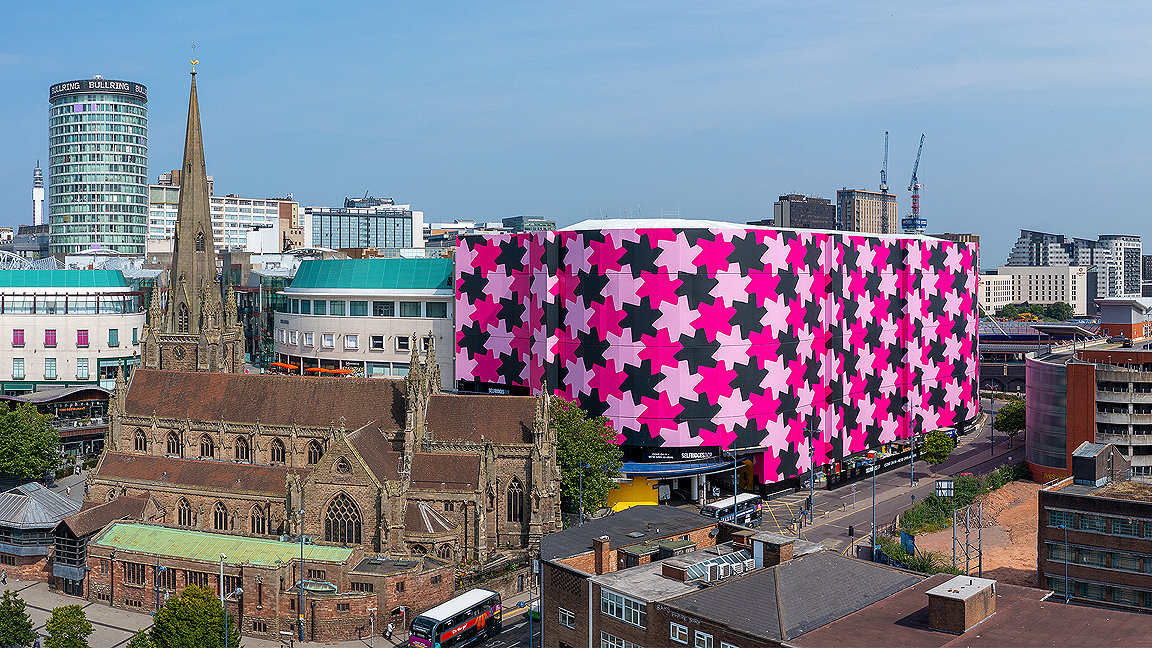
Selfridges store in Birmingham. Artwork by Osman Yousefzada, installed by Embrace Building Wraps
We’ve all walked past hundreds, if not thousands, of construction hoardings but have any of them ever made you want to stop for a closer look or take a photo?
Their main function is to act as a temporary perimeter fence, protecting passing pedestrians and vehicle traffic from the dust, debris and noise of the construction site contained within. However, they can also double up as prime advertising space. If you’re the owner of a retail unit that’s being rebuilt, it’s a way of marketing the business until the hoardings clear and the doors reopen for customers.
Alternatively, well-designed construction hoardings are a way of building positive relations with the local community. They are also the perfect platform for a large piece of public art, as seen on the Selfridges store in Birmingham, UK – when local artist Osman Yousefzada’s pink and black design building wrap could be seen for miles around.

Louis Vuitton hoarding during the renovation of their New Bond Street store. Photography by Richard Baker

Giraffe hoarding in the City of London. Photography by Richard Baker
Historical projects
In the case of culturally or historically important buildings, covering them up as little as possible means that visitors or tourists can continue to see what’s under the scaffolding. That’s what happened when the dome of the Capitol Building in Washington DC was restored between 2013 and 2016. The same approach was used when the Washington Monument was repaired between 2011 and 2014, after it suffered damage from a 5.8 magnitude earthquake and Hurricane Irene.
When renovations were carried out on Washington DC’s Supreme Court Building, it was covered in a protective scrim which depicted the unscathed building underneath. And when Paris carried out restoration work on the Panthéon it was covered in hundreds of portraits of French citizens.
London’s Banqueting House took a novel approach when a 14-month conservation project was being carried out – it used a building wrap installed by Northover&Brown which ‘peeled back’ a layer of the exterior and let people ‘see inside’ the building.

US Capitol Building

Banqueting House wrap design by Northover&Brown

Panthéon, Paris featuring artwork from the Inside Out project by JR
Vertical gardens
Using real greenery or ‘living walls’ is an increasingly popular option instead of traditional construction hoardings. The vertical garden approach brings nature into the city, while some plants absorb noise and help clean the air around a site.
Alistair Law is the founder of Vertical Meadow, a company that creates green, living walls for construction sites and permanent building façades. He says: “When using our system in a scaffolding sheet configuration, it can have significant noise reduction benefits. He also points out that using native species of plants is good for local wildlife, adding: “Using native wildflowers provides an additional stepping-stone for insects and birds to migrate across our cities.”
And as you’d expect from a green option, the creation and end-of-life process is more sustainable. “At the end of life, we have discussed moving our meadows to another construction site,” says Law. “The right opportunity has not yet materialised but is definitely feasible. We therefore recover all irrigation components and re-use them for the next project.”
In February 2022, Westminster City Council’s new Code of Construction Practice stipulated that all new construction hoardings of more than 50m in length must be green walls. It states: “Climbing plants are increasingly used on hoardings to improve visual amenity, resist graffiti, reduce noise and improve air quality through filtering dust and pollution.
“For Level 1 developments, when a horizontal length of more than 50 metres of hoardings needs to be erected adjacent to the public highway and where it is in place for six months or more, the incorporation of green hoardings must be used unless the developer provides a clear justification why this is not practicable.”



Living Wall Hoardings by Biotecture
A blank canvas for street art
In Australia, the city of Sydney requires developers using construction hoardings in high-traffic areas to cover them in art – either from a commissioned local artist or using historic images. It has also licensed 10 designs that construction companies can use for free. Those 10 designs are winners of a competition that received hundreds of submissions.
“Not only does the programme brighten streets and make the city a more pleasant place to visit and move through, it provides work for artists, many of whom struggled to exhibit through the pandemic,” says Sydney’s Lord Mayor Clover Moore.
Vancouver, Canada has also previously considered making murals by local artists on hoardings mandatory for new developments. This follows the success of a law passed in Toronto in 2014 which required developers erecting hoardings to allocate 50% of their surface area for community art.
With all the construction hoarding options available, plain wooden boards just don’t cut it anymore for the design-conscious developer.

Magic Circles by Kieran Butler, photography by Anna Kucera

Midnight Zoo by Studio A, photography by Anna Kucera

Artwork by Rosie Deacon, photography by Katherine Griffiths

Artwork by Prue Stent and Honey Long, photography by Anna Kucera



